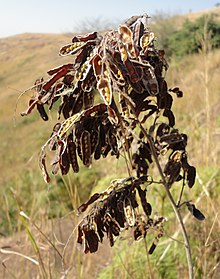
The genus Cajanus is a member of the plant family Fabaceae. There are 37 species, mainly distributed across Africa, Asia and Australasia.

Abrus is a genus of flowering plants in the pea family, Fabaceae, and the only genus in the tribe Abreae. It contains 13–18 species, but is best known for a single species: jequirity. The highly toxic seeds of that species are used to make jewellery.
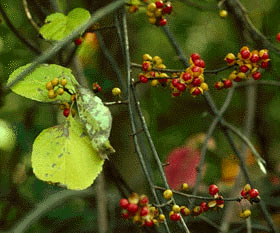
The Celastraceae are a family of 98 genera and 1,350 species of herbs, vines, shrubs and small trees, belonging to the order Celastrales. The great majority of the genera are tropical, with only Celastrus, Euonymus and Maytenus widespread in temperate climates, and Parnassia (bog-stars) found in alpine and arctic climates.
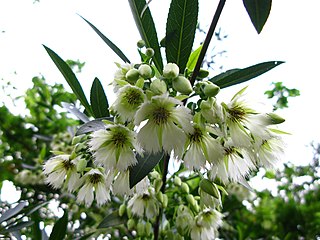
Elaeocarpus is a genus of nearly five hundred species of flowering plants in the family Elaeocarpaceae native to the Western Indian Ocean, Tropical and Subtropical Asia, and the Pacific. Plants in the genus Elaeocarpus are trees or shrubs with simple leaves, flowers with four or five petals usually, and usually blue fruit.

The plant tribe Phaseoleae is one of the subdivisions of the legume subfamily Faboideae, in the unranked NPAAA clade. This group includes many of the beans cultivated for human and animal food, most importantly from the genera Glycine, Phaseolus, and Vigna.
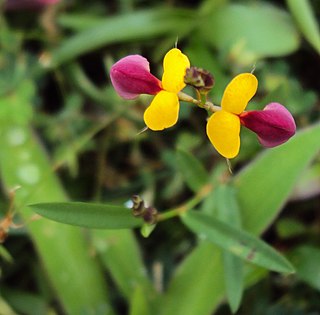
Alysicarpus is a genus of flowering plants in the legume family, Fabaceae. It is distributed in tropical and subtropical regions of Africa, Asia, and Australia. Species are known generally as moneyworts. Unusually for legumes, the leaves are simple.

Dichrostachys is an Old World genus of flowering plants in the family Fabaceae. Their Acacia-like leaves are bi-pinnately compound. Unlike Acacia their thorns are hardened branchlets rather than modified stipules. They are native from Africa to Australasia, but a centre of diversity is present in Madagascar.

Melhania is a genus of small shrubs or herbaceous plants. Traditionally included in the family Sterculiaceae, it is included in the expanded Malvaceae in the APG and most subsequent systematics. The genus is named for Mount Melhan in Yemen.
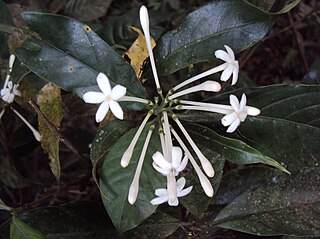
Tarenna is a genus of flowering plants in the family Rubiaceae. There are about 192 species distributed across the tropical world, from Africa, Asia, Australia to the Pacific Islands. They are shrubs or trees with oppositely arranged leaves and terminal arrays of whitish, greenish, or yellowish flowers.

Wendlandia is a genus of flowering plants in the family Rubiaceae. It is found in northeastern tropical Africa, and from tropical and subtropical Asia to Queensland.

Dunbaria is a genus of flowering plants in the family Fabaceae. It belongs to the subfamily Faboideae. It includes 19 species which range from India to Indochina, China, Korea, Japan, Malesia, New Guinea, and northern Australia.

Flemingia is a genus of plants in the family Fabaceae. It is native sub-Saharan Africa, Yemen, tropical Asia, and Australasia. In Asia the species are distributed in Bhutan, Burma, China, India; Indonesia, Laos, Malaysia, Nepal, Pakistan, Papua New Guinea, Philippines, Sri Lanka, Taiwan, Thailand and Vietnam. The genus was erected in 1812.

Galactia is a genus of plants in the legume family (Fabaceae). It belongs to the subfamily Faboideae and tribe Diocleae They do not have an unambiguous common name, being commonly called milk peas, beach peas or wild peas. They are perennial herbs or subshrubs with prostrate, climbing, or erect forms.

The tribe Desmodieae is one of the subdivisions of the plant family Fabaceae. It is composed of two subtribes, Desmodiinae and Lespedezinae. Recent phylogenetics has this tribe nested within tribe Phaseoleae.

The tribe Millettieae is one of the subdivisions of the plant family Fabaceae.

Pseudarthria hookeri, the pink velvet bean, is a lanky, perennial Afrotropical herb in the legume family, Fabaceae. It is named after William Hooker. It is widespread in the African tropics and moist uplands of the African subtropics, from Senegal and Ethiopia southwards to eastern South Africa. It bears rough trifoliolate leaves along the stem, and produces terminal, pink flowers in late summer. The stem may grow up to 2 or 3 meters in height annually, before it dies back in the dry season.
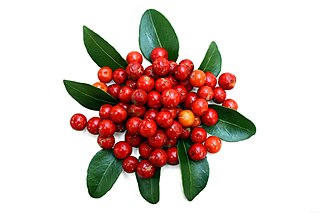
Drypetes sepiaria is a species of small tree in the family Putranjivaceae. This tree is very common in India and Sri Lanka. It is known by many local names, including vellakasavu, veeramaram in Malayalam, vellilambu, veerai (வீரை), aadumilukkan, kaayalakkamaram in Tamil, and weera (වීර) in Sinhala.
Anton Karl Schindler was a German dentist and botanist.
Neanotis is a genus of flowering plants belonging to the family Rubiaceae, and the major group Angiosperms.
